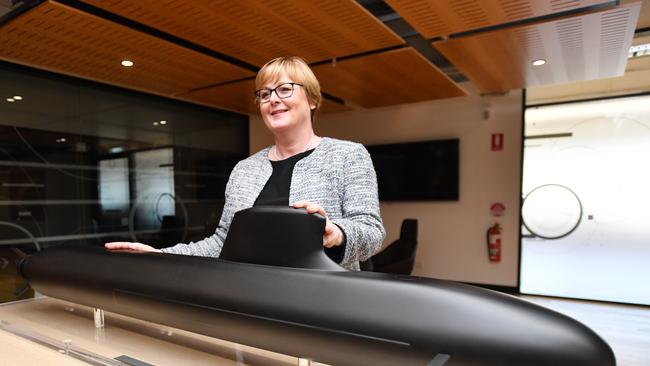Coronavirus: Pandemic shows up the gaps in military defences
This crisis reminds us that threats cannot be foreseen, and our defences must be ready.

— Lee Kuan Yew
The coronavirus has infected Australia’s strategic environment. It transforms our circumstances, multiplies and intensifies threats, and shatters any strategic assumption that could justify complacency, or even business as usual.
The Morrison government should respond to this new strategic urgency. Naturally, it has to get through the health crisis first. Within our defence establishment, serious work is under way on what the virus means for us and how it has accelerated every difficult, challenging and potentially deadly strategic trend we face.
Here are eight ways the virus has transformed our strategic outlook:
1.COVID-19 has smashed up altogether the idea of strategic warning time. Any security crisis today is come-as-you-are. You don’t get to wait for your ball gown to be made next year and fitted the year after. You have to cope with what you have. And we don’t have enough.
2. The virus has massively accelerated US-China strategic rivalry, which is now naked and ugly. A lot of this is structural, but it will be at a heightened intensity at least until the presidential election in November. Donald Trump thinks the perception of China as the origin of the virus is crucial to his re-election chances. And Joe Biden will not allow himself to look soft on China.
3. Beijing itself is cultivating a reaction of extreme nationalism at home and abroad. It will use this to cope with, and distract from, the inevitable economic difficulties, and it will also be much more assertive internationally, both militarily and diplomatically. The chance of some conflict coming about through miscalculation by Beijing is heightened.
4. Trump himself will be more unpredictable, more aggressive, more inward and more isolationist all at once, as the US copes with the ongoing devastation of the virus and he fights fiercely for re-election. One horrible straw in the wind is the US ending its Continuous Bomber Presence in Guam, under which it kept strategic bombers permanently stationed at its giant Western Pacific base.
5. A number of small Southeast Asian and South Pacific states, more important to us than to any outside player, may emerge from the virus as weakened states. Think of Papua New Guinea, East Timor and others. Even our giant neighbour and friend Indonesia could be seriously distressed by the time we get to the other side of the virus. All this increases the chance of instability, or of Beijing opportunistically increasing its regional influence to our detriment.
6. Biological warfare has new salience. COVID-19 began probably in a wildlife wet market. It is certainly not a biological weapon. But every potential adversary, from states with malicious intent to the better organised terrorist groups, has seen what the virus has done to the West, and marvelled.
7. We will need to do much more to have any independent defence capability in a region where the nations we are least friendly with are surging militarily. That will cost money. But we will have less money post-COVID-19 because we will have a smaller economy, lower growth and more debt.
8. We will lose, at least for a time, our natural growth engine of high immigration. Defence capability flows in part from economic size. We won’t be increasing our economic size so quickly or so automatically as in recent years.
The Morrison government has been an able steward of national security, and it is working hard to try to come to grips with this rapidly changing strategic environment. But much of the work is behind the scenes.
It has had many successes, but its chief failure so far has been an unwillingness to project a narrative about how the Australian Defence Force serves national security.
The government projects effectively on strong borders, resisting international interference and the importance of the US alliance. It has not projected so well on the nature, role and purpose of the ADF. That is now a dangerous gap.
Defence Minister Linda Reynolds some weeks ago received from the Defence Department the draft defence strategic update. She commissioned this shortly after the election. The document will eventually be considered by the national security committee of cabinet and, specifically, by Scott Morrison.
This is a kind of defence mini-white paper. It doesn’t purport to take decisions on specific equipment purchases. But it does interrogate and update all the basic strategic analysis that drove the 2016 defence white paper.
The document is fairly frank. It is likely that a milder public version will be released in due course. There is no serious criticism of the government for not having yet completed its consideration of this document. The government has been busy trying to avert a pandemic disaster, and trying to do so at the lowest economic cost. But, ultimately, nothing is more vital than national security. We need to be able to take care of ourselves.
The best thinking in the federal government today accepts that the virus has changed the security environment. But a particular line of analysis is becoming popular: that the virus doesn’t necessarily change the direction of history, or the drivers of history, but it does accelerate history and it heightens pre-existing tensions.
The defence strategic update suggests that, even before the virus, all the drivers identified in the 2016 white paper have been accelerated in the past three years. Most important, the strategic competition between Washington and Beijing is intensifying.
There is an increase in our region of coercive activities and so-called grey zone activities. The type of incident that falls under both categories is Beijing using naval ships disguised as coast guards or even commercial vessels to harass or even sink Southeast Asian shipping in the South China Sea. There is also massive military modernisation and expansion by Beijing — and a similar trend, at less intense levels, by other regional nations.
This sharply impacts on Australia’s determination to keep a regional edge in defence equipment and to maintain the ability to deter aggression.
The paper examines emerging and disruptive technologies, such as sea mines or swarms of weaponised drones controlled by artificial intelligence, the emergence of hypersonic weapons, high-speed and long-range weapons, which have huge implications for the ability of a military asset to defend itself. The flip side is obvious — namely, that Australia too must possess such capabilities if it is to maintain deterrence.
Naturally, the paper examines issues such as cyber warfare, which continues to grow rapidly in our region, and more traditional questions such as terrorism.
The paper concludes that Australia needs to develop more self-reliant capabilities in defence; but it also judges that the US alliance is absolutely fundamental to our national security.
Reflecting the government’s own priorities, even before the coronavirus came along, the paper examined, as part of human security, issues of pandemic response, as well as the Defence Force’s ability to assist in scenarios such as bushfires and other natural disasters, and similarly the ADF’s ability to offer critical assistance in the South Pacific.
The paper looks to see where Australia can maximise the advantages of asymmetry through using key assets, namely technology, geography and relationships with allies and partners, chiefly of course with the US. Asymmetry means imposing unreasonable costs on an enemy at a small cost to ourselves.
Australia’s defence strategy is often misunderstood. People can conclude that with just 26 million people, Australia is too big a country to defend. This is dead wrong. It is true that ultimately Australia could be overwhelmed by a determined superpower that didn’t care how many casualties it took.
A coherent defence strategy can make it impossible for us to be overwhelmed by any but a determined superpower, and can make the cost even to a superpower unacceptably high.
Lee Kuan Yew, the legendary Singapore statesman and — historically — Southeast Asia’s most sagacious strategic thinker, described the strategy for his small city-state nation as making itself into a “poison shrimp”.
Australians may not like the imagery of fashioning itself into an inedible emu or a bitter kangaroo, but LKY’s pungent imagery is right. Australians should understand what defence policy really is. It is, at its heart, the ability to apply deadly kinetic force to an enemy, to close with and kill, capture or destroy the enemy and his military assets. The more a nation like Australia possesses that capability, the less likely it is ever to have to use it.
The Defence strategic review will examine numerous asymmetric strategies available to Australia. A key concept is area denial. That means our military force may not be able to control an entire area such that it can impose its will, but it does have the ability to deny any other power from operating freely in the area.
One way of doing this might be through sea mines, which are now far more intelligent and dynamic a resource than were the old-fashioned mines. These might prevent an adversary from operating across an entire area. Australia will want to have “area denial” capabilities in the air, on land and at sea — especially in our maritime approaches.
The Morrison government is determined to increase the lethality of the ADF, so as to increase its ability to fight and survive in high-intensity environments.
One move under active consideration is the purchase of 200 or more long-range anti-ship missiles. The US congress has given approval for these to be sold to Australia. They would be carried by our Super Hornets. These are an intensely capable new generation of missiles that have the ability to seek out their target independently, to avoid and deflect defensive measures, and to be launched from a long way away. Their range is hundreds of kilometres and could be extended even farther.
This means if an adversary is sending ships to do harm to Australia, it must take into account the ability of Australia — independently of what any other nation might do — to potentially destroy those ships in transit.
The existing submarine, frigate and offshore patrol vessel projects are all good and will give Australia significantly increased capability.
The government needs to do much more to explain the subs. There has not been a significant cost blowout since an indicative cost was determined in 2016. The latest reported blowout is simply a consequence of the fall of the Australian dollar. It could just as easily rise over the coming years, and that would decrease the cost. Moreover, the many billions of dollars thrown around in discussing this project often overlooks the fact this money will be spent gradually over decades.
The likelihood is the French Barracuda-class subs will be the best conventional subs in the water. The simple truth is that anyone opposed to the French subs is really opposed to Australia having a submarine capability at all. And you can’t defend Australia without submarines.
But the problem with the subs and the frigates is they are too far away — 2030 for the first frigate, 2034 for the first sub. Australia needs to do a lot to increase the lethality of the ADF a long time before then.
The federal government will almost certainly have to commit to life-of-type extensions for all the Collins-class subs.
One of the most promising platforms is the offshore patrol vessels, coming online very soon. They have been conceived as constabulary vessels, but really they are the size and sturdiness of combat ships. There’s no reason they couldn’t carry missile loads, towed sonar arrays or a variety of other weapons systems.
COVID-19 not only disrupts our strategic environment, it teaches us the world is instantly unpredictable — and potentially deadly. History has taught us that. Recently, we seem to have forgotten this. Now we have no excuse.




In a world where big fish eat the small fish, and the small fish eat shrimps, Singapore must become a poison shrimp.